Cycling, journalism, and beauty. A lot of beauty
The victory of an injured Pogačar in Strade Bianche is a golden chapter in his legend. One step closer to eternity.
Tachycardia, emotion, and an unprecedented happiness.
That’s what Henri-Marie Beyle felt the first time he laid eyes on Santa Croce in Florence. The overwhelming accumulation of such vast, pure beauty left him unsteady. Without realising it, he was experiencing a phenomenon that would later become famous with the ‘democratisation’ of tourism. Without knowing it, he was giving a name to one of those syndromes that end up more renowned than their own discoverers. Beyle went down in history under a different name. Beyle was Stendhal.
On Friday, almost at midnight, I arrived to Siena to experience my first Strade Bianche in person. In fact, it was the first international race I attended as an accredited journalist, making the excitement twice as intense... But as I passed through the first gate of the medieval walls into Siena’s historic centre, desperately looking for somewhere still open to grab a bite, I forgot about the race, the journey, the hunger. I forgot about almost everything and just thought about how long it had been since a city had struck me like this. Fountains, palaces, cobbled alleyways, little squares with sculptures appearing out of nowhere. What the hell is this? My hunger could wait a little longer.
And then, La Piazza. An absolute wonder. I had already glorified this place because of the Strade, because of the photos… But it’s even more beautiful in real life. Even better.
That Friday night, I thought of Stendhal and how, in another corner of Tuscany, beauty hit me without warning.
The preview
On race day, I wanted to get up as early as possible to see the city in daylight and arrive with plenty of time to collect my accreditation near the rider sign-in and presentation at Fortezza Medicea, one of the Renaissance gems the Medici left behind in Siena. And, in the process, I confirmed that my reaction the night before hadn’t been an overreaction. Siena is simply incredible.
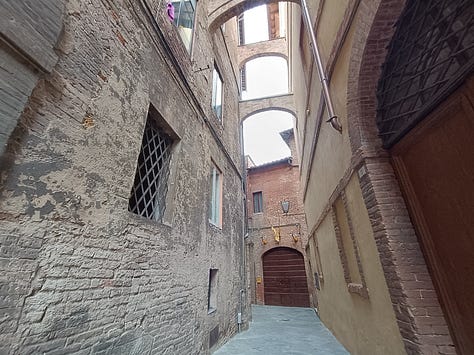
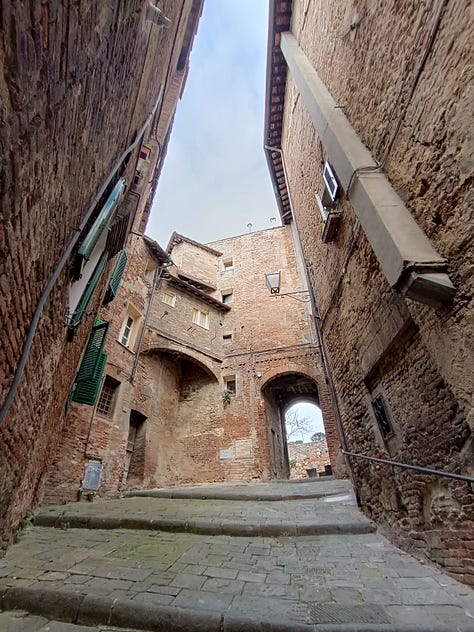
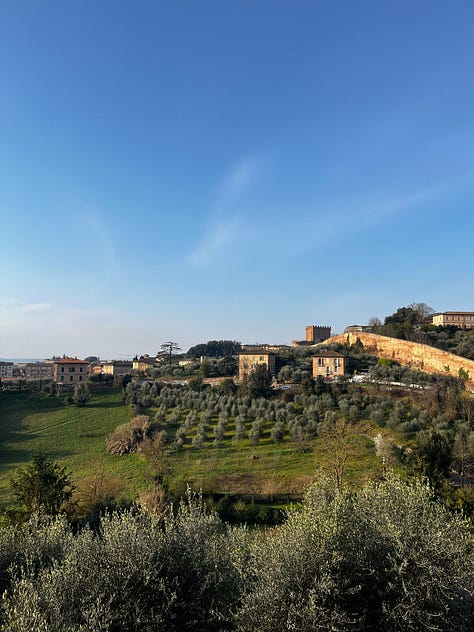
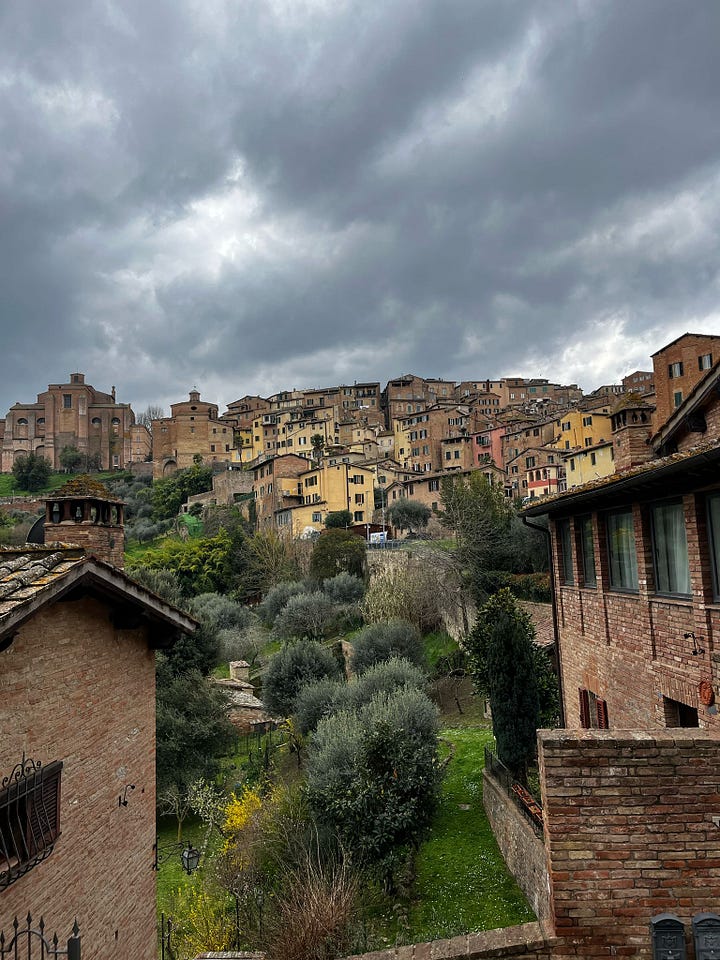
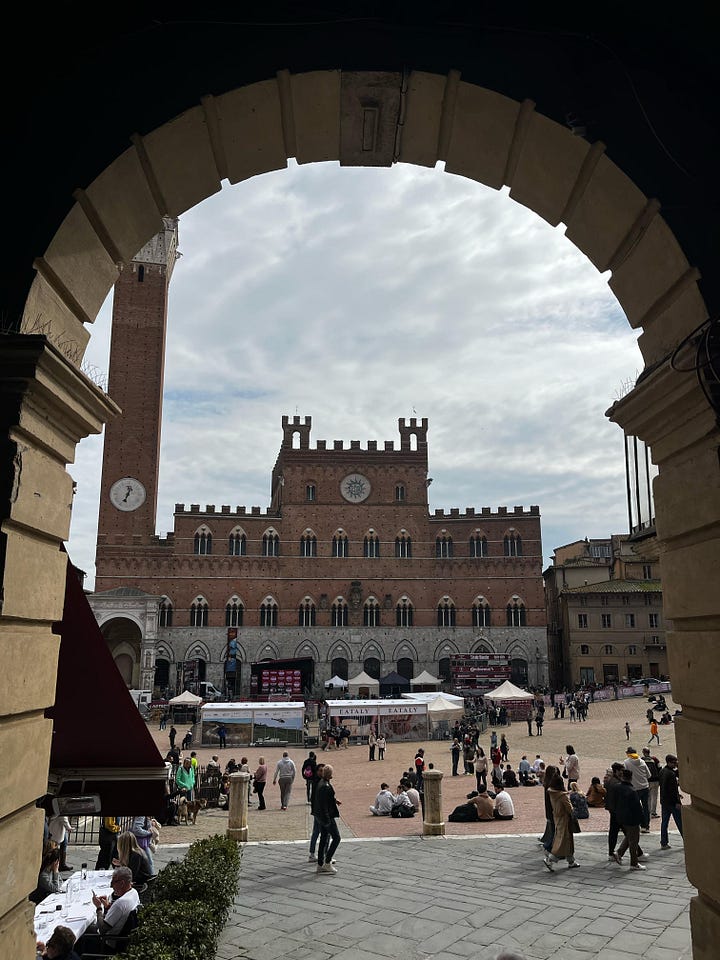
After going over my notes on topics to discuss with potential interviewees and checking my audio-video setup about 7 times, I started speaking with some of the key figures. I was accredited for the Spanish podcast A la Cola del Pelotón, so the goal was to get as many Spanish-speaking riders as possible.
I spoke first with Ion Izagirre, who admitted he wasn’t feeling at his best at this stage of the season.
I appreciated his honesty. He could have just given me a vague answer or told me he was fine, like most of us do, whether it’s true or not. I also liked that he downplayed the UCI points situation. Of course, it’s a crucial issue for Cofidis’ future, but without the right safeguards, that anxiety can turn into pressure. And not everyone on that team has Ion’s experience to manage it.
Then, I had the chance to chat with Richard Carapaz.
The Ecuadorian is deep into his preparation for his biggest goal of the year: the Giro d’Italia. I asked him whether Strade was a target in itself or if he was mainly there to recon the Siena stage of the Giro. He told me it was a mix of both, but in the end, the EF rider finished nearly 25 minutes behind Pogacar and was never really in contention. What caught my attention was how he referred to the Siena stage as a day where "some riders could lose the Giro."
I also spoke with Carlos Canal, from Movistar. A fast rider with punchy qualities and CX experience, he’s part of an exciting young generation alongside Romeo, Castrillo, Pelayo Sánchez or Barrenetxea.
For Canal, who mentioned Formolo as the team’s leader (14th place), Strade Bianche is "the most beautiful race of the year." Can’t argue with that, Carlos.
I was particularly eager to speak with Roger Adrià, a debutant at Strade and one of the most improved riders on the cycling elite in recent years. His path to the WT has been less conventional, developing later than others.
He talked about how he felt during his debut at Opening Weekend and his expectations for this race, where he finished 10th but spent much of the race in podium contention.
Regarding his breakaway in Kuurne with Van Aert, he admitted that team orders prevented him from working in the move as Red Bull wanted to bet everything on a sprint with Jordi Meeus. At the time, I thought it was a bad call from the German team. After rewatching it, I still thought it was a bad call. And after speaking with Adrià, I remain convinced. This guy is for real.
And of course, I had to talk to the Spanish fan favorite: Mikel Landa. On his first race day of the season, he was unsure about his form and how he would handle Strade Bianche, a race he had never done before. He arrived "very relaxed" but believed he had a shot due to the course changes, which he felt were "more suited for climbers."
How do you beat Pogacar?
"I don’t know… He’s the best uphill, the best on the flat, he’s not afraid to go solo, and he’s incredibly skilled on the bike."
If anyone can, it's you.
"If I switch to a motorbike, maybe."
Jokes aside, Landa put in a solid performance, finishing 11th and showing that this is a race where he can do well. More importantly, it served as good preparation for the Giro and his upcoming goals.
Finally, I interviewed Marc Hirschi just before the start. It wasn’t his best day (24th), though he had high hopes for a podium finish. He reminded me of a key factor in this race: luck plays a big role and the competition is brutal.
In his first direct showdown with Pogacar as a rival since Liège 2020, Hirschi admitted that the only way to beat the Slovenian was to have incredible legs… and anticipate his attacks. Maybe that's exactly what Tom Pidcock was thinking when he launched his move 78 kilometers from the finish.
The attack
The biggest difference compared to any race scenario in the past year, starting with Strade Bianche 2024, was that Tadej Pogacar didn't make the first move. Instead, Tom Pidcock attacked early, forcing both of them to break away 78 km from the finish.
It didn't take long for them to bridge to the early breakaway, where Connor Swift, the strongest rider in the group and a Tro-Bro Léon winner, was still holding on.
I find it surprising how some teams underestimate the importance of breakaways in races like this. Having a rider up the road, knowing the attacks will come early, can create huge tactical advantages as you can’t play these matches face to face.
Another notable difference from anything we've seen in 2024 is that Pogacar couldn’t drop Pidcock when he counterattacked. Even though he's riding at an astronomical level and no human has ever gone faster on a bike, it feels like he's lost just a tiny bit of explosiveness. Not much… but maybe just enough that a single acceleration is no longer enough to shake off every single rival.
In exchange, however, he can hold an insane pace on any terrain, push more watts than anyone on the climbs and destroy races, even in the face of adversity.
The crash
The key moment of the race was Pogacar’s crash. While his Liège 2023 accident was far more severe, leaving him with a broken wrist and months off the bike, this was the first time we’ve seen him go down in a race like this.
Despite the brutal impact, Pogacar was actually lucky. He entered the corner too fast, lost control, and suffered multiple abrasions, but the somersault he took could have easily ended with a broken collarbone.
Beyond the crash itself, what stands out is Pidcock’s line through the corner. Unlike Pogacar, he took a much cleaner trajectory, barely needing to adjust his position or to react.
Pogacar admitted later that his mistake put his breakaway companions at risk. In fact, it completely cut off Connor Swift, and, according to INEOS sources, the team felt that Pogacar’s crash cost them a near-certain podium in Strade Bianche.
So, the big question: Did Pogacar take unnecessary risks out of recklessness, or was he trying to prove a point against Pidcock, arguably the best descender in the world?
Could Pidcock have attacked harder downhill once Pogacar got back to him?
The comeback
Before the race, I wrote that Strade Bianche was a Tadej vs. Tadej battle, but in reality, it turned into Tadej vs. the elements. Pogacar usually chooses to win in epic, but this time he had no other option. And what a comeback it was.
There's been a lot of debate about whether Pidcock should have waited for Pogacar after his crash. Let’s be clear: Pidcock didn’t wait for anyone.
The British kept pushing after the incident, as he should. He had no idea if Pogacar was still in contention and had a chasing group (Bilbao, Wellens, Healy, and Adrià) trying to close the gap, plus Connor Swift still up the road.
In the 4 kilometers between Pogacar’s crash and his return to the front, something crucial happens: the gap between Pidcock and the chasing group increases. That’s clear proof that Pidcock never slowed down.
So how did Pogacar catch up so fast? He delivered one of the best 5-minute power efforts of his life. He erased more than 30 seconds, despite his bike change. When Pogacar gets within 15 seconds, Pidcock eases up slightly, drinks some water, takes a moment to breathe. Was this his choice or a team order? We don’t know. But what’s certain is this: Pidcock didn’t wait, he simply got caught.
The final move
At Colle Pinzuto, Pogacar launched his final attack. A seated acceleration, an infernal rhythm and a plan to ride the last 18 km solo.
The defining image? Pidcock standing, almost sprinting, desperately trying to hold the wheel… But failing. Pidcock’s race was bold and brilliant. A masterclass in endurance, skill, and raw watts. But even bruised, Pogacar is on another level.
The Photo
March 8th gave us the best sports photo of 2024. Alen Milavec, Pogacar’s personal photographer, spent €50 for a spot on a bar terrace in Piazza del Campo. From there, he captured THE PHOTO. The hero, the finish, the crowd, La Piazza and the pure essence of Strade Bianche.
This race always fuels the “sixth Monument” debate. It has a perfect marketing engine, a Gran Fondo the next day, and now, a revamped course with more kilometers and more elevation. But beyond all the discussions, Strade Bianche is simply unique. It delivers a rare style of racing, set in a city that feels like it was built for this moment. Alen’s photo? Iconic. But Siena makes it easier.
The finish line
After the race, I waited at the finish line, hoping to catch the riders’ raw reactions. Mauro Gianetti, CEO of UAE, stood there, his expression a mix of joy and disbelief, just minutes before embracing Pogacar in a moment of shared euphoria.
I saw Pidcock and Pogacar exchange mutual respect, and Pogacar waiting for Tim Wellens, his teammate who completed the podium.
Then there was Roger Adrià, completely empty after losing positions on the brutal Via Santa Caterina, barely able to speak. Mikel Landa looked the same. But Pello Bilbao? He was all smiles. “Super satisfied,” he told me, after securing 5th place, his fourth career top 10 at Strade Bianche.
Bilbao explained me that Wellens refused to take turns because Pogacar was ahead. Despite a solid collaboration with Healy and Adrià, they had no answer for Wellens’ attack. "That wasn’t our rhythm," he admitted. Still, he wished he could have finished alongside Adrià and let the road decide their fate.
I had to laugh when his teammate, Portuguese debutant Afonso Eulálio, crossed the line. Bilbao asked him if he had enjoyed the race. "NO," Eulálio answered with a breathless chuckle.
The finish-line images told the real story: dust, blood, ragged breathing, faces of exhaustion. This is L’Eroica.
The “Lucky Guy”
"I'm the lucky guy. My new nickname”, he said.
At the press conference, I asked Pogačar about what did he say to Pidcock after the crash.
"I said sorry to him. It could have ended really bad for everyone in the front group… For Tom, for Swiftie… It was my fault. I said sorry, and he just asked if I was okay. That was it. We kept going."
On whether Pidcock had waited for him, he was honest:
"For sure, when I got close, he waited for me. I don’t know… it was still a long way to the finish. Maybe he thought it was better to be together."
And just like every year, he seemed tired of the never-ending “sixth Monument” debate.
Beauty, epicness, life
At the end of the day, sport is just an excuse. An excuse to go outside, to travel, to eat, to meet people, to feel impressed, to share stories. To remind us that, on days like Saturday, humans can seem like something more than just that.
Strade Bianche is valuable in its own right, but my first L’Eroica, hopefully the first of many, was the perfect excuse for Pogačar and Siena to "Stendhalise" me.
The victory of the wounded hero is an epic tale that further elevates a figure still fighting against history, chasing eternity. Yet at the same time, it humanises him, offering vulnerability, proof that he can be beaten, that he makes mistakes.
I will forever remember my first glimpse of Piazza del Campo, the expressions of the riders who had pushed far beyond the threshold of pain and the roar of the streets surrounding the Piazza, electrified, screaming for the arrival of the Chosen One, like a wounded but triumphant knight, just before riding into La Piazza del Campo at the Palio di Siena.



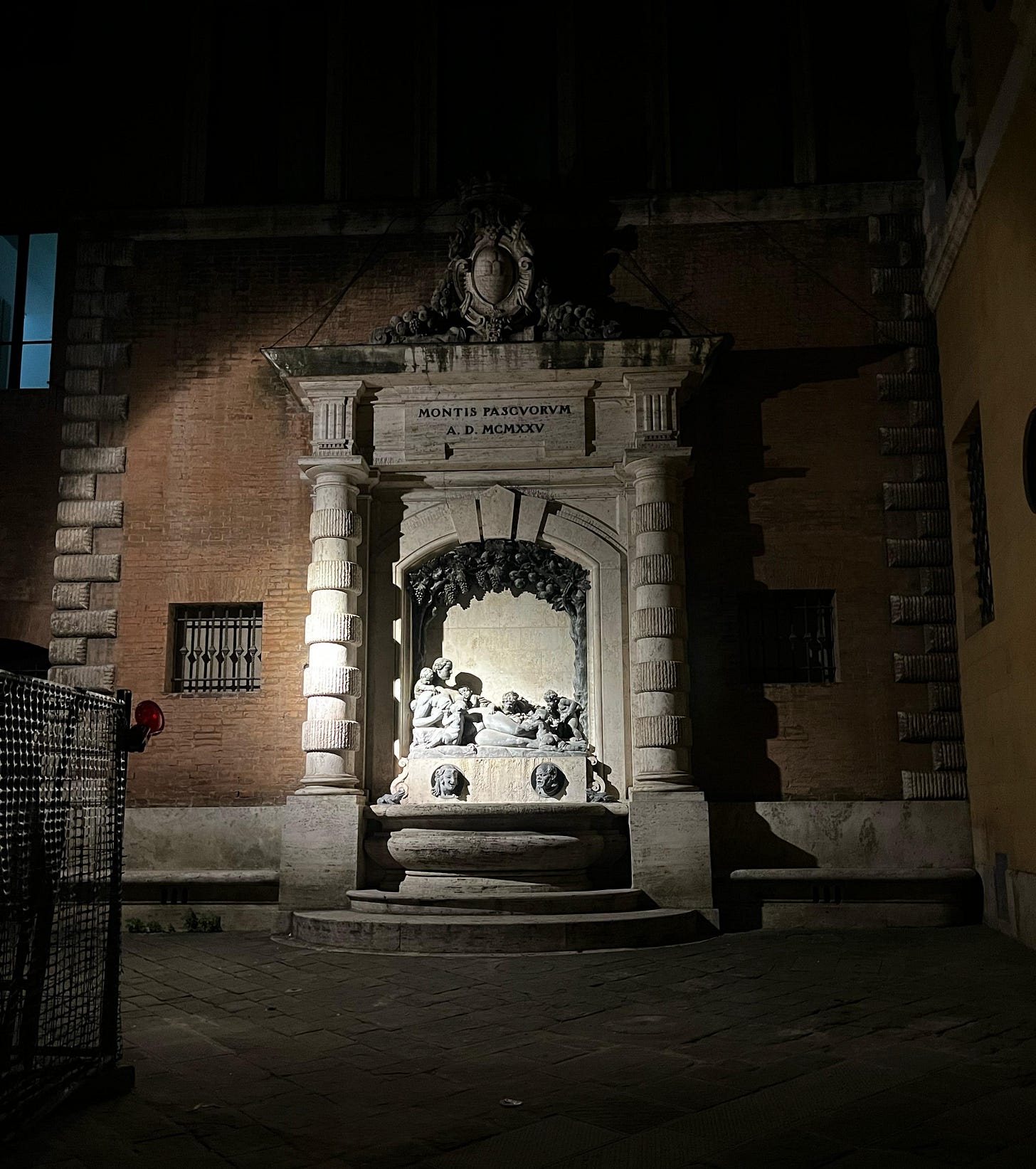
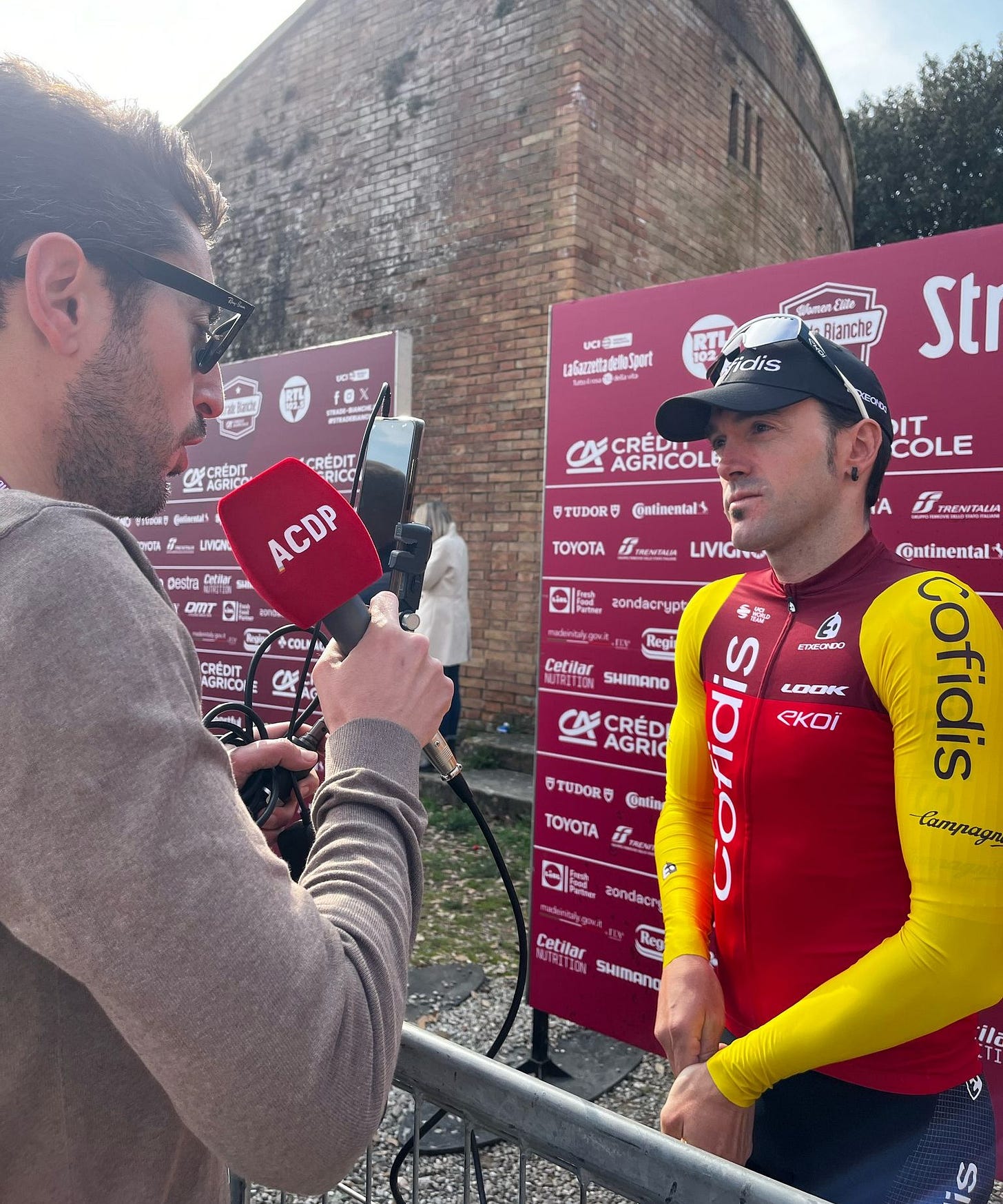

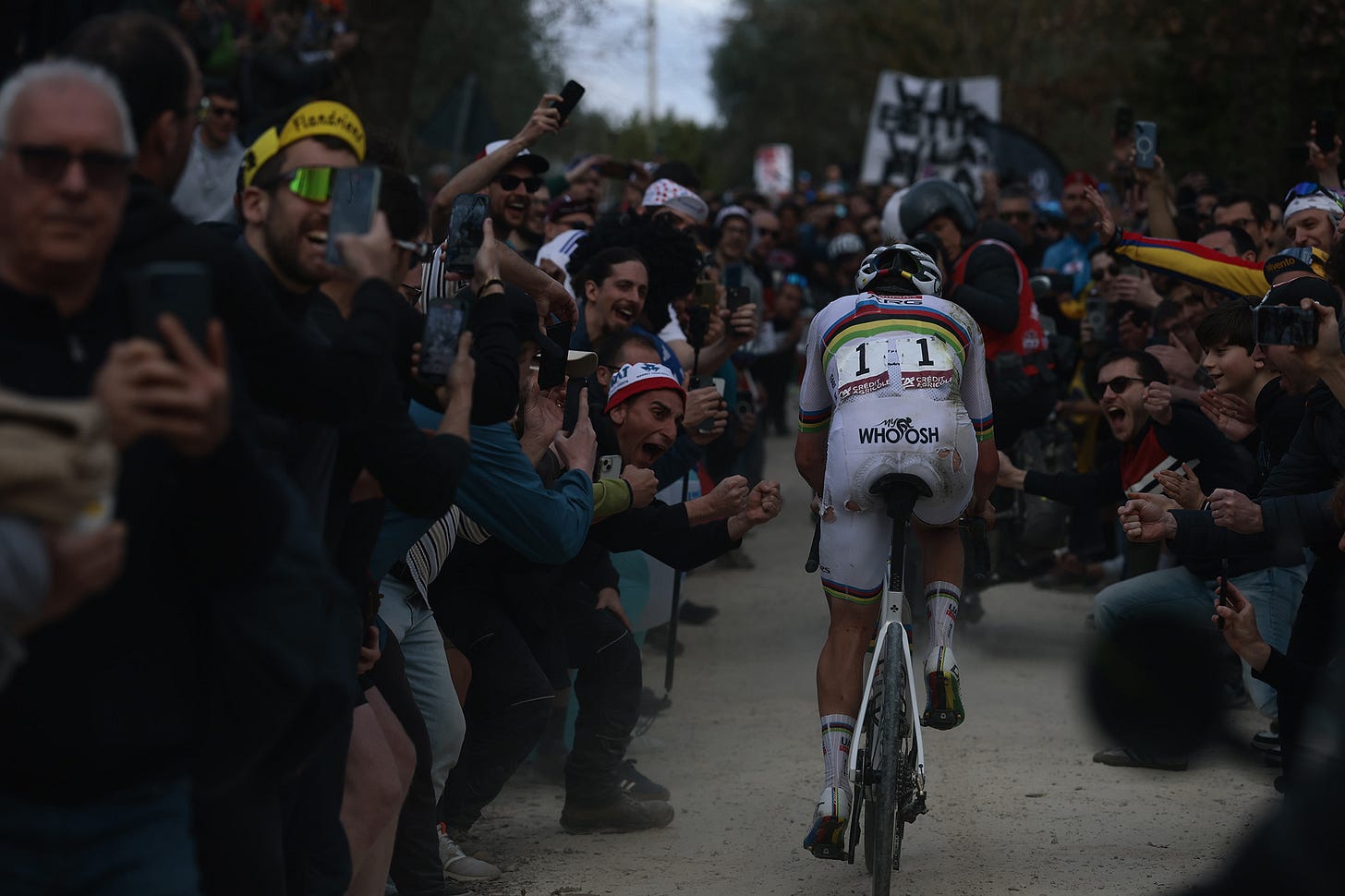

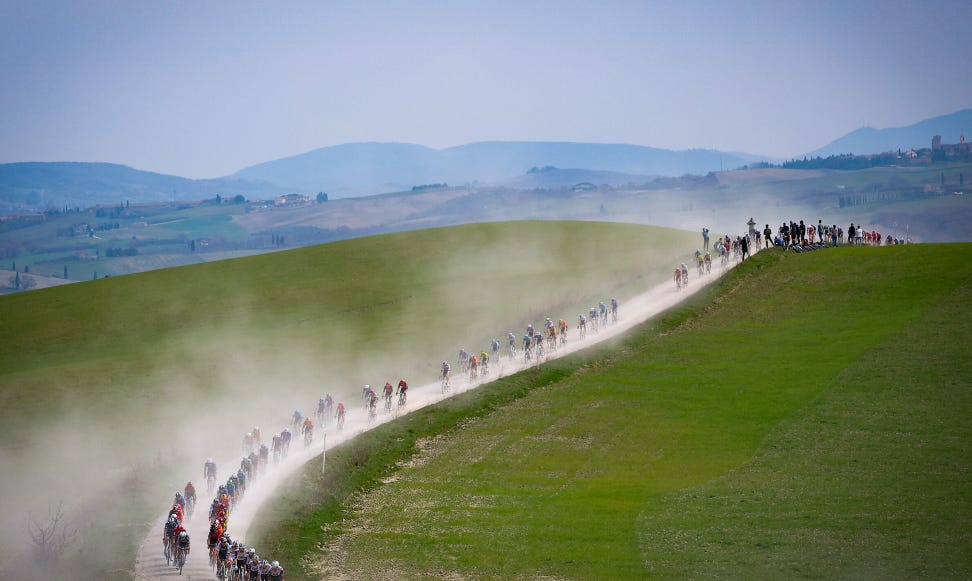
An absolute epic. Great piece, thanks for sharing your experience!